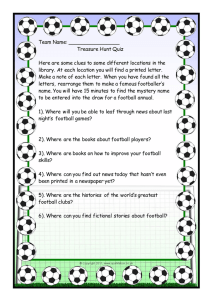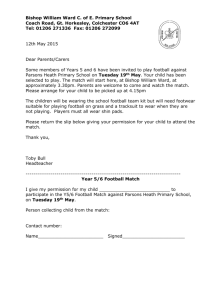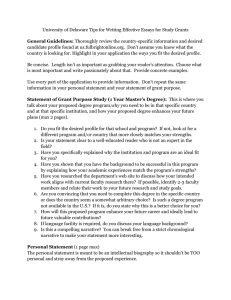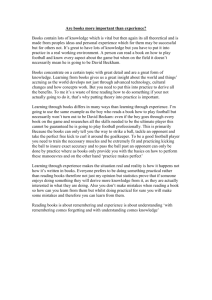Football and Head Impact: To Play or Not to Play
advertisement
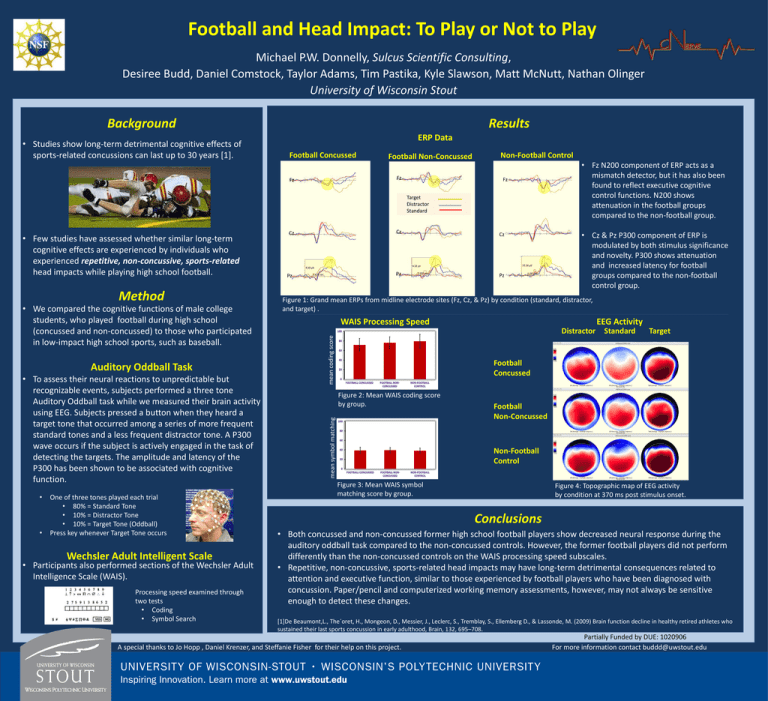
Football and Head Impact: To Play or Not to Play Michael P.W. Donnelly, Sulcus Scientific Consulting, Desiree Budd, Daniel Comstock, Taylor Adams, Tim Pastika, Kyle Slawson, Matt McNutt, Nathan Olinger University of Wisconsin Stout Background • Studies show long-term detrimental cognitive effects of sports-related concussions can last up to 30 years [1]. Results ERP Data Football Concussed Football Non-Concussed Fz Fz Non-Football Control Fz Target Distractor Standard • We compared the cognitive functions of male college students, who played football during high school (concussed and non-concussed) to those who participated in low-impact high school sports, such as baseball. Auditory Oddball Task • To assess their neural reactions to unpredictable but recognizable events, subjects performed a three tone Auditory Oddball task while we measured their brain activity using EEG. Subjects pressed a button when they heard a target tone that occurred among a series of more frequent standard tones and a less frequent distractor tone. A P300 wave occurs if the subject is actively engaged in the task of detecting the targets. The amplitude and latency of the P300 has been shown to be associated with cognitive function. • • One of three tones played each trial • 80% = Standard Tone • 10% = Distractor Tone • 10% = Target Tone (Oddball) Press key whenever Target Tone occurs Wechsler Adult Intelligent Scale • Participants also performed sections of the Wechsler Adult Intelligence Scale (WAIS). Processing speed examined through two tests • Coding • Symbol Search Cz Pz Pz • Cz & Pz P300 component of ERP is modulated by both stimulus significance and novelty. P300 shows attenuation and increased latency for football groups compared to the non-football control group. Figure 1: Grand mean ERPs from midline electrode sites (Fz, Cz, & Pz) by condition (standard, distractor, and target) . WAIS Processing Speed EEG Activity Distractor mean coding score Method Cz Standard Target Football Concussed Figure 2: Mean WAIS coding score by group. mean symbol matching • Few studies have assessed whether similar long-term cognitive effects are experienced by individuals who experienced repetitive, non-concussive, sports-related head impacts while playing high school football. Cz • Fz N200 component of ERP acts as a mismatch detector, but it has also been found to reflect executive cognitive control functions. N200 shows attenuation in the football groups compared to the non-football group. Football Non-Concussed Non-Football Control Figure 3: Mean WAIS symbol matching score by group. Figure 4: Topographic map of EEG activity by condition at 370 ms post stimulus onset. Conclusions • Both concussed and non-concussed former high school football players show decreased neural response during the auditory oddball task compared to the non-concussed controls. However, the former football players did not perform differently than the non-concussed controls on the WAIS processing speed subscales. • Repetitive, non-concussive, sports-related head impacts may have long-term detrimental consequences related to attention and executive function, similar to those experienced by football players who have been diagnosed with concussion. Paper/pencil and computerized working memory assessments, however, may not always be sensitive enough to detect these changes. [1]De Beaumont,L., The´oret, H., Mongeon, D., Messier, J., Leclerc, S., Tremblay, S., Ellemberg D., & Lassonde, M. (2009) Brain function decline in healthy retired athletes who sustained their last sports concussion in early adulthood, Brain, 132, 695–708. A special thanks to Jo Hopp , Daniel Krenzer, and Steffanie Fisher for their help on this project. Partially Funded by DUE: 1020906 For more information contact buddd@uwstout.edu
